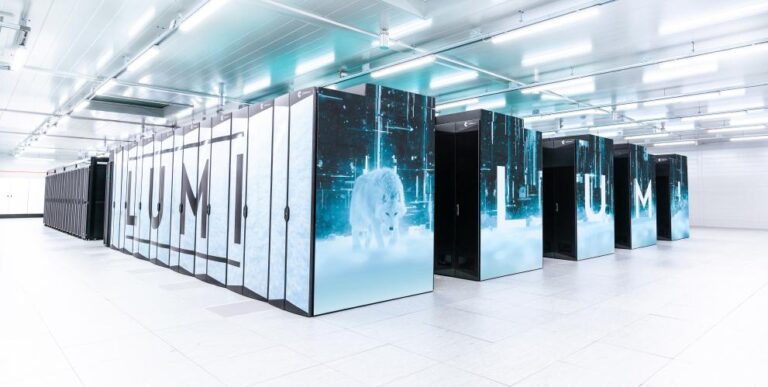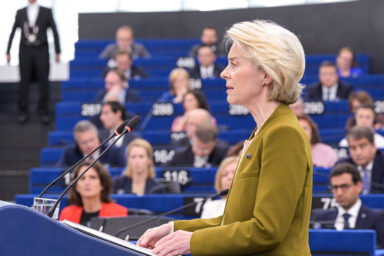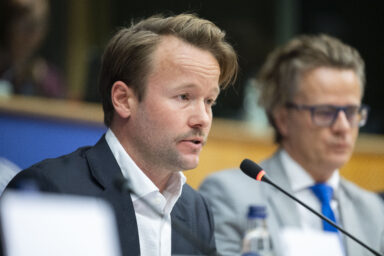The European Union wants to be more than the world’s leading regulator of artificial intelligence. With the AI Continent Plan, unveiled last year, the European Commission is betting billions on a network of “AI Factories” that combine supercomputing power, data resources and industrial know-how.
While Brussels debates how to catch up with the US and China in artificial intelligence, the first wave of AI Factories is already paving the way. Some stand out by scale, others on sustainability or innovation, but all are part of a broader plan to anchor AI development in Europe.
EU Perspectives spoke with leaders from AI Factories in Finland, Germany, Slovenia and Spain. While their views vary, they converge on the need to strengthen European sovereignty and to chart a long-term vision for AI in Europe.

Big scale in Finland
The LUMI AI Factory in Finland is the flagship of the project. Built on one of the world’s fastest and greenest supercomputers, LUMI already serves six countries, Czechia, Denmark, Estonia, Finland, Norway and Poland, and is expanding through a new “AI Factory Antenna” programme that anchors regional hubs into its network.
“We naturally see our role to be the enabler of the most demanding AI endeavours”, says Aleksi Kallio, Director of LUMI AI Factory Services. But scale, he insists, is not an end in itself. “We are also the largest by reach (6 countries, with more joining through the “AI Factory Antenna” program), which means that we must make our services useful for a wide range of users: from small companies to big enterprises, and from academic research to commercial innovation”, he added.
You might be interested
That balance is visible in the projects it powers. OpenEuroLLM, the EU’s initiative to develop its own foundation models; Destination Earth, a high-resolution digital model of the planet; and OpenWebSearch.eu, a project building an open web-data infrastructure for search and generative AI.
Germany bets on trust
If Finland represents scale, Germany’s HammerHAI reflects Europe’s pragmatism. Based in Stuttgart, with a focus on engineering and “global challenges”, such as climate change, migration streams and pollution, the factory pitches itself as a trusted, local partner for industry.
“One of our unique selling points is trust”, says Dennis Hoppe, one of HammerHAI’s project managers. “If you’re an industrial user, do you rely on a remote, anonymous US cloud, or on a data centre two kilometres away where you can talk to a person and know where your data lives?”.
Do you rely on a remote, anonymous US cloud, or on a data centre two kilometres away where you can talk to a person and know where your data lives? – Dennis Hoppe, HammerHAI
HammerHAI has already partnered with Stuttgart startup Seedbox to train a 70-billion-parameter European language model and to set up a GDPR-compliant inference service with a ChatGPT-style interface, hosted locally.
Managing director Bastian Koller sets a clear goal for their role in the European landscape. “Our job is to understand what users need, from large companies to the startup around the corner”.
Slovenia cross-border AI collaboration
Slovenia’s AI Factory, SLAIF, based in Ljubljana, builds on a strong academic tradition and the Vega supercomputer. It contributes directly to EuroHPC through cross-border collaborations and federated AI learning projects. The aim is to link with other centres, supporting joint model development, shared training content and common access frameworks.
“These efforts will reinforce interoperability and scalability across Europe’s emerging federated AI infrastructure”, say directors Florian Klauser and Jan Jona Javoršek. Partnerships with Austria and Italy, through the Leonardo supercomputer consortium, the IT4ALIA initiative, and collaborations on EuroHPC competence centres and the Austria-Slovenia annual HPC conference, will anchor resource sharing, expert exchanges and joint access portals. SLAIF is also extending ties to Poland, Sweden, Slovakia and the Western Balkans to strengthen regional cohesion and build a broader pan-European ecosystem.
Its experts collaborate with researchers across domains ranging from material design and pharmacology to high-energy physics, computational linguistics and the humanities. The centre is also linked to IRCAI, the UNESCO Center in Artificial Intelligence.
Applied innovation in Spain
In Barcelona, the BSC AI Factory is positioning itself as a hub for applied innovation. Coordinating with Portugal, Türkiye and Romania, it offers tailored services for companies and public institutions in sectors such as healthtech, agriculture, finance, media and government. “By connecting supercomputing centres, universities, startups, industry, the public sector and financial stakeholders, AI Factories will enhance collaboration in AI across Europe”, says Mariona Sanz, Head of Innovation and Business Development at the Barcelona Supercomputing Centre.
The BSC AI Factory will play a key role in positioning Europe as a leader in responsible, cutting-edge AI by connecting research excellence with practical innovation – Mariona Sanz, BSC AI
“In particular, the BSC AI Factory provides access to high-performance infrastructure, expert guidance, and sector-specific support (in fields such as healthtech, agriculture, climate and blue economy, finance and legal, energy, communication and media, and public sector)”, she added.
Funding the AI dream
For now, the factories are funded 50/50 by the EuroHPC Joint Undertaking and national governments. That model has kept the first wave afloat, but scaling up will demand far deeper resources and greater private involvement.
Barcelona Supercomputing Center is already experimenting with ways to bring companies closer. “BSC is already developing long-term, self-sustainable initiatives for the future of the BAIF”, says Sanz. “One of these is BSC Connects, where we provide companies with direct access to applied knowledge, opportunities to collaborate on strategic projects”. HammerHAI, by contrast, has no private funding yet, though Koller acknowledges it may become necessary as systems grow.
For the SLAIF Director, the challenge is as much financial as cultural. Europe, he argues, has been slower than competitors to back commercial applications and startups. “Our culture of funding the development of commercial applications, productions systems and start-ups, is not as agile as it is in US and recently
in China, as well as some other countries in South-East Asia”, he says. That lack of agility has pushed many European firms to scale in America while keeping their research at home. The hope, Klauser adds, is that the AI Factories and the broader Continent Plan can shift the balance, “help us put our potential to better effect in a commercial as well as everyday context”.
Data is a key priority
One common point for all is that data sovereignty is fundamental for Europe’s AI ambitions. For Kallio at LUMI, computing power alone will not secure Europe’s future in AI. Data, he argues, must stand alongside compute and talent as the third pillar of sovereignty. “Besides computing and talent our third pillar is data, which is critical for technological sovereignty, because data is crucial for creating real value”. Europe has the resources, but in his view, what matters is ensuring they are controlled and used inside Europe. “Our mission is to provide the trustworthy platform to bring the data archives alive in an open and unbiased manner”.
The question on data sovereignty is however critical for Europe, and this must be solved urgently – Aleksi Kallio, LUMI
That logic underpins LUMI’s “Datasets as a Service” model, designed to make data that was previously too large, sensitive or restricted available for AI training. Without such efforts, warns Aleksi Kallio, Europe could squander its advantage. “A great deal of the data we produce in our daily activities is leaking outside Europe”, he says. To change this, the EU needs to take firm steps to ensure scalability of open web data services and data platforms alongside HPC capacities. For Kallio, the stakes are high: “The question on data sovereignty is however critical for Europe, and this must be solved urgently”.
Others in the network echo the concern, though with different solutions. SLAIF is investing in an AI learning project, which allows models to be trained across borders without moving sensitive data, a way of pooling knowledge while respecting privacy and sovereignty rules. HammerHAI takes a collective approach. “Industrial data is Europe’s strength”, says Hoppe. He calls for a cross collaboration model: “We should join forces on software stacks, user management and security so users and data can move between AI factories seamlessly”.
Sustainability as an asset
If funding is one challenge, energy is another. Training large AI models is energy-intensive, and Europe’s climate commitments leave little room for unchecked growth. All four factories stress their green credentials, but in different ways.
LUMI runs entirely on hydroelectric power, uses outside air for cooling and channels waste heat to supply up to 20% of local households. SLAIF’s new centre is built on a river island, directly connected to a hydropower plant and the city heating network. In Germany, HammerHAI has chosen a phased approach. Starting with smaller systems that expand gradually, with waste heat reused on campus. Barcelona’s BSC is developing methods with the Aragonese research institute CIRCE to monitor the energy consumption of heterogeneous computing resources and optimise workload placement.
The message is consistent across the continent. European AI capacities are positioning sustainability as a competitive advantage in order to differentiate European AI as environmentally responsible.
Future of European AI
Despite their differences, Europe’s AI Factories share a long horizon. None sees themselves as mere supercomputing sites. Each positions itself as part of a wider ecosystem that should take shape over the next decade.
At HammerHAI, Koller recognises the challenge: “Europe has often fallen behind because knowledge was fragmented and strategies were too often national rather than European. Now we have a chance to put this together”. For his team, the future means seamless access. “In the best case, the EuroHPC ecosystem looks to end-users like a single environment”, adds Dennis Hoppe. “If one site is fully booked, you can simply move your workload to another AI Factory, for example, to LUMI, with your data already there and ready to use”.
In Finland, the focus is on people skills. “We need to have also human capital in this ecosystem – so developing people’s understanding and capabilities is essential”, says Kallio. He also stresses the importance of scale. “Another question is if we can build large enough collaborations that can go beyond the level of fairly good and make waves on the global scale”.
As soon as we overcome the initial shock in the education system, I think we will see that Europe with its strong and well-established public education is in a good position to make sure we really leverage the advent of AI to the benefit of society as a whole – Florian Klauser and Jan Jona Javoršek, SLAIF
While Slovenia looks to education. “As soon as we overcome the initial shock in the education system, I think we will see that Europe with its strong and well-established public education is in a good position to make sure we really leverage the advent of AI to the benefit of society as a whole”, argues Klauser.
Spain, meanwhile, stresses applied innovation. Mariona Sanz expects a focus on mainstreaming AI into everyday business and society. “The BSC AI Factory will play a key role in positioning Europe as a leader in responsible, cutting-edge AI by connecting research excellence with practical innovation”, she says. “It will also help boost AI expertise in SMEs and startups across diverse sectors, enabling companies to leverage advanced AI capabilities for real-world applications”.
For Brussels, the goal is to have, by 2026, at least 15 sites online, backed by nine AI-optimised supercomputers and a €20bn fund.











